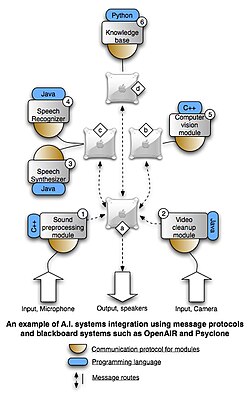
AI and unified communications are teaming up in a big way. It's not just a trend; it's changing how we work. Businesses using AI in their communication systems can boost productivity by 25%. Unified communications bring together different tools and platforms, and AI is making them smarter. Think about it: communication systems that connect, learn, adapt, and even predict what you need. In this article, we'll explore how AI is enhancing connectivity and collaboration across different fields. We'll look at real-world uses, ethical questions, and give you a step-by-step guide on how to get started. Let's see how AI is shaping the future of unified communications.
Summary: This article discusses the integration of AI into unified communications, highlighting AI-driven features, practical use cases, industry applications, challenges, ethical considerations, and implementation steps. It provides a comprehensive overview of how AI enhances unified communication systems.
Unified Communications and AI Integration: A Comprehensive Guide
Unified Communications (UC) and UCaaS Explained
Unified Communications (UC) brings together different ways to communicate—like email, phone, video, and messaging—into one platform. This setup makes it easy for people to communicate and work together without jumping between apps or losing track of conversations.
UC includes tools like:
- Instant messaging
- Video calls
- Presence detection
- Cloud hosting
These tools work together to cut costs and boost productivity. Unified messaging takes it a step further by collecting emails, texts, and voicemails into one inbox, syncing everything in real-time.
Unified Communications as a Service (UCaaS) takes these features to the cloud, making it simple for both remote and office workers to stay connected. With cloud-based tools, businesses can be more flexible, letting employees connect from any device, anywhere there's internet.
UCaaS offers essentials like:
- VoIP calls
- Video meetings
- Team collaboration tools, including call recording and screen sharing
Companies like RingCentral, Zoom, and Microsoft Teams offer these solutions, supporting remote work and global communication.
How AI Enhances Unified Communications
AI enhances Unified Communications by automating and improving how we communicate. It can clean up background noise and enhance video quality during calls. Additionally, AI assists with tasks such as:
- Summarizing meetings
- Taking collaborative notes
- Managing calls smartly with routing and transcription
By analyzing user behavior, AI can determine availability, providing a clearer picture of who can collaborate in real-time.

When AI is integrated into UC systems, it creates smarter workflows that reduce manual work and boost team productivity. For instance, during a video call, AI can automatically remove background noise, transcribe the conversation, and summarize it with action points. This allows participants to focus on the discussion rather than note-taking.
AI also enhances security by detecting unusual activity and automating compliance, ensuring communication remains smooth and secure.
AI-Driven Features Enhancing Unified Communications
AI-Powered Meeting Insights and Automation
AI is revolutionizing the way we conduct meetings. With features like transcription, summarization, and key point highlighting, meetings become more productive and equitable. Consider the Zoom AI Companion; it aids in summarizing meetings, drafting emails, and facilitating smoother communication. This allows participants to focus on the conversation without the distraction of note-taking.

Moreover, AI can coordinate schedules by checking everyone's calendars to find the optimal meeting time, reducing the usual back-and-forth. Post-meeting, AI can assign tasks based on discussions, enhancing team efficiency.
AI-Enhanced Security and Compliance in Unified Communications
AI plays a crucial role in securing communications by monitoring for unusual activity and potential threats, preventing issues before they arise. This is especially vital as more interactions occur online. AI also supports compliance by logging communications and ensuring proper data handling.
For example, smart call routing and chatbots ensure that sensitive interactions are managed by the appropriate personnel, minimizing compliance risks. They can even detect and flag suspicious behavior in real-time. Akkadian Labs exemplifies how AI enhances security and compliance in communications.
AI-Driven Analytics and Reporting for Unified Communications
Through AI, businesses can predict and address issues before they occur by analyzing customer interactions. This capability helps optimize operations and communication strategies. By 2026, it is anticipated that most companies will utilize AI-enabled tools for personalized engagement and data-driven decision-making.
AI-powered analytics provide businesses with insights into communication patterns, helping predict customer needs and enabling timely responses. These insights are invaluable for refining communication strategies and boosting efficiency. Comcast Business highlights AI's growing role in unified communications.
AI-Driven Messaging and Collaboration Tools
AI chatbots are transforming customer support by offering 24/7 assistance, handling simple inquiries, and escalating complex issues to human agents. Natural Language Processing (NLP) enhances call routing and message comprehension, speeding up responses and improving customer satisfaction.
AI also facilitates real-time translation and captioning in meetings, enabling seamless collaboration among geographically dispersed teams. Smart messaging tools offer instant chat translations, allowing global teams to communicate effortlessly, regardless of language barriers. These tools are essential for fostering a connected and efficient work environment. Hexicor illustrates AI's impact on messaging and collaboration.
In summary, AI features are enhancing unified communications by automating tasks, boosting security, providing deep analytics, and transforming messaging and collaboration. These advancements streamline workflows and promote effective and inclusive communication, ultimately enhancing productivity and efficiency across organizations. As the market for unified communications expands with AI-driven tools, businesses that embrace these technologies are well-positioned to thrive.
Practical Use Cases and Industry Applications of Unified Communications
Unified Communications Case Studies Across Industries
Unified communications (UC) platforms are revolutionizing how industries operate by integrating multiple communication tools into a seamless system. Here's how different sectors are benefiting:
Automotive Industry:
UC platforms enhance collaboration among sales teams, management, service departments, and customer support by consolidating calls, texts, and service updates. This unified approach boosts customer satisfaction and loyalty through features like mobile apps and smart call routing.
Retail Sector:
Retailers use UC to connect in-store staff with customer support and online sales teams. This integration allows for real-time inventory updates, instant messaging, and coordinated promotions across locations, enhancing the shopping experience and streamlining operations.
Restaurants:
Restaurants benefit by managing all customer inquiries—calls, emails, and texts—in one centralized location. This leads to faster responses and happier customers. Additionally, they can track customer details, offer contactless ordering, and send order updates and promotions.
Hospitality:
In the hospitality industry, UC platforms provide smart call routing and interactive voice response (IVR) systems to handle guest calls efficiently, reducing wait times and offering immediate updates on room changes, maintenance, and emergencies. They also ensure guest information security with PCI-compliant measures.
Notable Example:
Coca-Cola implemented a UC solution to unify different communication platforms across its global network. This initiative reduced IT complexity and costs, enhanced security, and allowed IT resources to focus on more strategic tasks.

Enhancing Unified Communications with Deepbrain AI and AI Studios
Integrating AI with unified communications enhances collaboration tools with features like real-time transcription, translation, and AI-driven virtual assistants that handle routine tasks such as scheduling and reminders. This integration significantly boosts productivity, especially for geographically dispersed teams.
Customer Experience Enhancement with AI-Powered UC:
AI-powered UC platforms improve customer experience by employing chatbots for instant support and sentiment analysis to gauge customer emotions during interactions. This capability helps businesses personalize service and respond more swiftly.
AI-Driven Call Routing in Unified Communications:
AI-driven call routing reduces wait times and improves first-contact resolution by matching calls with the appropriate agent based on customer intent, agent expertise, and real-time data. Predictive analytics assist call centers in anticipating call volume and optimizing staffing.

Innovative AI Solutions for Unified Communications:
Deepbrain AI focuses on developing advanced AI models that integrate seamlessly with UC platforms, offering intelligent virtual assistants and chatbots. Meanwhile, AI Studios provides platforms that enable businesses to create custom AI applications without requiring deep coding skills. Both initiatives demonstrate how the fusion of unified communications and AI can drive innovation and enhance business processes across various sectors.
For further reading, check out these resources:
Unified Communications Solutions Guide
UCaaS Benefits
AI Impact on UC
Challenges and Ethical Considerations in Unified Communications
Overcoming AI Adoption Barriers in Unified Communications
Bringing AI into unified communications (UC) systems isn't without its hurdles. Here are some of the main challenges:
Network Performance: Adequate bandwidth and low latency are crucial for handling video calls and real-time chats. Introducing AI features like transcription and analytics increases data traffic, demanding robust infrastructure.

Integration with Existing Systems: Ensuring seamless operation with legacy systems and various business tools requires strong API support and adherence to open standards. This avoids vendor lock-in and maintains flexibility.
Security and Privacy Concerns: Incorporating AI necessitates zero-trust architectures, end-to-end encryption, and detailed access controls to safeguard communications.
User Adoption: Transitioning to AI-enhanced systems involves user-friendly interfaces, clear migration plans, and comprehensive training to ensure a smooth changeover.
Continuous Evolution: The dynamic nature of AI technology requires ongoing updates and adaptations, which can strain resources and expertise.
Cost Implications: The investment in new hardware, software licenses, training, and maintenance can be substantial, posing challenges for small to medium businesses.
Ethical and Data Privacy Considerations in Unified Communications
Unified Communications (UC) platforms collect a significant amount of sensitive information, raising important ethical and data privacy concerns:
Compliance with Data Protection Laws: Adhering to regulations like GDPR is essential to responsibly handle personal data and avoid legal issues.

Transparent AI Usage: Ethical AI use involves clarity in data collection and usage, granting users control over their information, and explaining AI decision-making processes.
Bias in AI Algorithms: Addressing biases in AI algorithms is crucial to prevent unfair treatment of users.
Vendor Selection: Evaluate vendors based on their ethical practices, such as compliance with security standards like ISO 27001 and GDPR, to ensure trust in AI integration within UC environments.
For more insights on unified communications, visit UC Today.
Implementing AI in Unified Communications: A Step-by-Step Guide
Unified Communications Needs Assessment and Vendor Selection
Start by figuring out what you need. Look at your current communication workflows and see where they fall short. What do you want to achieve with your unified communications (UC)? Maybe it's quicker response times, lower costs, or better teamwork.
- Set clear goals and track them with measurable KPIs.
- Check your hardware, software, and network to spot any integration issues. You'll want everything to work smoothly with new UC solutions.
Look for vendors with AI features like real-time language translation, speech recognition, smart call routing, and AI-driven security. Make sure their solutions boost performance and reliability.

For example, a mid-sized company did an IT audit, found issues with old systems, and chose a UC vendor with AI-driven call routing and transcription to boost customer support.
Unified Communications Training and AI Integration
Getting the top brass on board is key. Teach your leaders about AI communication tools so they can lead by example. Address any employee worries about AI taking jobs by showing it's a tool to help, not replace.
- Prepare your infrastructure for AI with fast networks and reliable systems.
- Add AI features like virtual assistants for call routing and automated transcription to make work easier.
- Provide training for employees to use these tools effectively.

Some companies set up AI panels to engage staff, train them on AI tools, and upgrade networks for AI features.
Measuring ROI and Continuous Improvement in Unified Communications
Set KPIs to see how AI-powered UC is improving things like response times, teamwork, and cost savings. Use AI analytics for insights into customer satisfaction and performance.
- Keep an eye on system performance with AI-driven maintenance to minimize downtime.
- Regularly update AI algorithms based on data and feedback to improve security and user experience.
- Stay in touch with stakeholders to review progress and tackle any challenges.
For instance, a company might track reduced wait times and better customer sentiment with AI analytics while keeping AI models up-to-date for compliance and uptime.
Conduct a thorough needs analysis to evaluate current communication workflows. Consider AI-powered UC vendors that offer advanced features. Gain executive buy-in by educating C-suite leaders. Monitor system performance using AI-driven predictive maintenance.
Unified Communications FAQ
AI's Role in Enhancing Customer Satisfaction in Unified Communications
AI significantly enhances unified communications by streamlining processes and improving user experience. It effectively eliminates background noise during video calls, ensuring conversations are clear and enjoyable. This allows participants to focus on the discussion without being distracted by unwanted sounds.
Additionally, AI simplifies the transition between different communication tools and devices. It automatically detects user presence, facilitating seamless collaboration for teams, regardless of their location. This reduces the complexity of managing multiple gadgets or platforms.
Moreover, AI features in UC platforms organize communication workflows, preventing missed messages and disjointed chats. This connectivity and accessibility boost customer satisfaction. AI also generates automated meeting summaries and notes, allowing users to engage in discussions without worrying about note-taking, as key points are saved for future reference.

Challenges of Integrating AI in Unified Communications
Integrating AI into Unified Communications as a Service (UCaaS) presents several challenges. A primary issue is the technology required to detect presence and context across various devices, complicating system development and maintenance. Ensuring seamless integration of different communication channels—like voice, video, and messaging—is difficult due to varying protocols and platforms.
Data privacy and security are critical concerns since AI processes sensitive communication data. Companies must implement robust protections and comply with regulations to safeguard this data. Additionally, user adoption of AI features can be challenging if they are not intuitive or disrupt existing workflows. Well-designed interfaces and comprehensive training programs are essential to encourage the use of AI tools.
Enhancing Security in Unified Communications with AI
AI plays a crucial role in securing unified communications. It continuously monitors communication patterns in real-time to identify anomalies that may indicate security threats, such as unauthorized access or phishing attempts. AI-powered call screening and spam detection further protect against fraudulent calls. Machine learning enhances threat detection by learning from new security incidents within the UC environment.
AI also supports secure authentication methods, like voice biometrics, providing an extra layer of security for users. These advanced measures make unauthorized access more difficult, safeguarding sensitive information.
Additionally, AI automates routine security tasks, improving the efficiency of security operations and ensuring swift threat response.
For more detailed insights into unified communications and its components, you can explore resources from 3CX and Genesys.